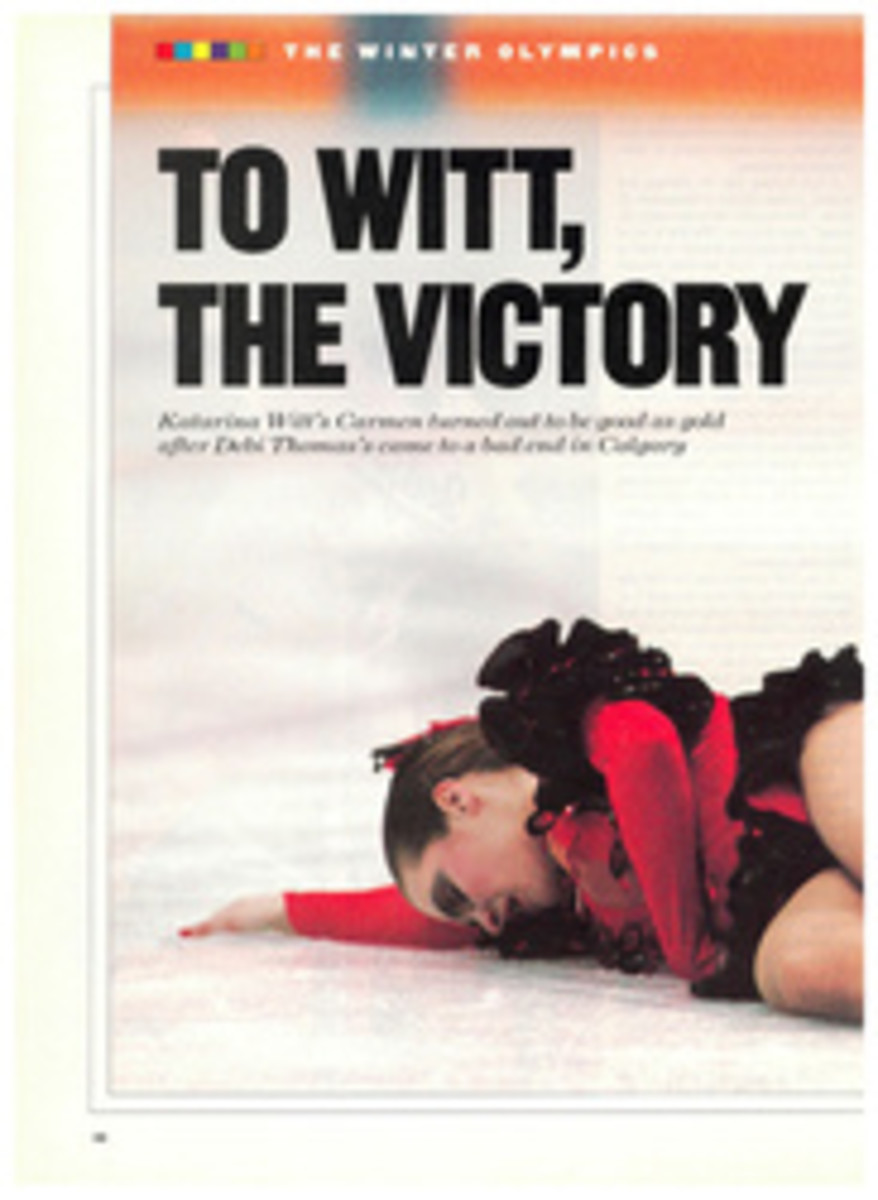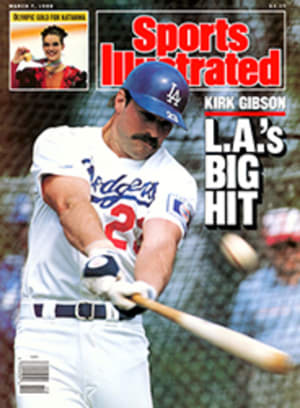
SLIPPIN' AND SLIDIN'
Going into Sunday morning's final heat of the Olympic four-man bobsled event, Brent Rushlaw, the glowering, mustachioed blue-collar bobber from Saranac Lake, N.Y., was somewhere nobody expected him to be: in sixth place and still very much in contention for a medal. Standing at the top of the track at Calgary's Canada Olympic Park, he grabbed the side of his sled, gave a grunt and then pushed off. It was a typical Rushlaw start—not a great one, but not terrible, either. The guy is 36 years old, after all, and this was his fourth Olympics.
Once in the driver's seat, Rushlaw summoned up all those years of experience and drove a perfect race—low in all the turns, straight as an arrow through the Kreisel, the most dramatic curve on the track. His time of 57.20 was faster than those of both drivers before him and would turn out to be the best in the fourth round. Now all he had to do—all he could do—was wait.
The sun was beating down, melting the ice and making the track slower and slower. GDR II came down and couldn't catch Rushlaw. Both Austrian sleds, which had been barely ahead of him going into the last run, fell behind. Suddenly there was only one sled left—USSR II—and Rushlaw was still in third place overall.
The Soviet sled driven by Janis Kipurs equaled the fastest start time of the day and was fast through the upper third of the course. But as it neared the bottom it began to slow down dramatically, though, for Rushlaw, not quite enough. When Kipurs drove over the finish line, he was ahead of Rushlaw for the bronze medal by .02 of a second. At 75 mph, that's about the length of five beer cans, which is a fitting yardstick considering that Rushlaw is renowned for guzzling suds. The fourth-place finish was still the best by a U.S. sled since the American four-man bob got the bronze at Cortina in 1956. "We'll get 'em in four years," said Rushlaw.
Rushlaw's near miracle shifted the bobsledding focus away from what had been a circus on ice. Earlier in the week some gritty performances by veteran drivers from the Soviet Union, East Germany and Switzerland had been overshadowed by several comic—nearly tragic—performances by sliders from such bobsledding meccas as the Virgin Islands, Mexico, New Zealand, Australia, Portugal, Taiwan and Jamaica. The field was so crowded with Sunday afternoon sliders, in fact, that the sluggos staged their own competition at the bottom of the standings.
Some purists found this a shameful turn of events. "If I were a bobsled athlete, I'd be really ticked off that there were 10 or 15 sleds basically chewing up the track," said Abby Hoffman, director general of Sport Canada, the federal agency that oversees amateur sports. "When half the countries competing are within 10 degrees of the equator, something's wrong."
Hoffman might have been off by a degree or two, but the fans didn't care. They liked these crazies. Whenever a Soviet or East German sled came whooshing down the track, holding a perfect line, half the crowd was off buying hot dogs on a stick and a can of Blue. But when sliders from the tropics were on the course, the wall of humanity was 10 deep at trackside, everyone hootin', hollerin' and havin' a hell of a time. Up, down and up the curves went the Mexicans. Bang, bang, bang went the Portuguese. Wheeeee!
The king of the Booby Derby was Prince Albert of Monaco. An unassuming guy, he walked around the Olympic Village introducing himself to female athletes with a simple, "Hi, I'm Albert." Like we didn't know. Albert's sled swooned in his presence, too, and his team placed 25th out of 41 in the two-man event. His was the best bobsled finish ever for Monaco, but His Serene Highness said he hopes to improve on it four years hence in Albertville. That's a town in France that, despite what its name might indicate, he does not own.
Nearly as popular as Prince Albert in the can was the Jamaican team, which underwrote its trip to the Olympics by selling ultracool sweatshirts and which had its own reggae theme song that went, in part, "We be trainin', gainin', strainin' and painin', but we ain't complainin'/Jamaica bobsled, ragamuffin, Jamaica bobsled, we ruff n tuff'n/Everything cool, mon."
When asked about his team's newfound celebrity, Jamaican driver Dudley Stokes said, "I don't know why the people like us so much. It's not something I should talk about." But one female spectator who had met the Jamaicans shed some light: "They have a great sense of humor and are good dancers."
Then on Sunday all the fun came to an abrupt stop. Until that day the Jamaicans had been helped by warm chinooks that had melted the ice and slowed down the course. But now the air was cold—27°—and the track was fast. The Jamaican four-man sled came careening down the course in its usual frenzied style, hit the Kreisel like a runaway bumper car and then tried to exit too high at 73 mph. Everything not cool, mon. The sled flipped over on its side, slammed its passengers headfirst into the wall and continued on its terrifying course toward the finish. The Jamaicans, painin' severely but not seriously injured, took a bizarre heroes' march up the outrun, shaking hands and waving. They were out of the competition, and the debate was on as to whether such inexperienced racers would ever be allowed to participate in the Olympics again.
While the Jamaicans and their ilk played havoc with their sleds, the real bobsledders were engaged in some stirring competition at the other end of the results sheet. The Soviet Union's Kipurs took the lead in the second heat of the two-man event after defending champion—and first-round leader—Wolfgang Hoppe of East Germany drew a late starting position and had to slog his way in 60° heat down a melting track. Even though Hoppe ultimately finished first in three of the four heats, he placed eighth in the second one. And his time was nearly a second slower than the clocking for the first run of the day, turned in by none other than Prince Al.
The two-man event was concluded two days later in freezing temperatures that had turned the slush into congealed, bumpy, rutted, dirty guck. "There were thick clumps of ice," said Hoppe, who gained on Kipurs in each of the last two heats but still had to settle for silver. "Sometimes it was almost impossible to miss the damaged parts of the track. The whole thing has been rather nerve-racking."
In the four-man race Hoppe, again the defending Olympic champion, was beaten by .07 of a second by Ekkehard Fasser in Switzerland I. Hoppe was .68 ahead of Kipurs. And Kipurs was that microscopic .02 ahead of Rushlaw.
Until Rushlaw's performance all the news from the U.S. camp had been bad. The Americans' ills started before the Games, when they got embroiled in a nonsensical controversy over who would be on the team. A Harvard student named Don LaVigne filed a grievance with the USOC after he lost his position on the team to Willie Gault of the Chicago Bears. Facing an arbitration hearing, the USOC and the U.S. Bobsled Federation convinced the IOC to allow LaVigne to be reinstated. Everyone, including, presumably, LaVigne, knew that he wasn't going to compete, but he ended up having a good time in the Olympic Village, anyway. As one waggish reporter summed up the situation, "Leave it to a Harvard guy to sue for the right not to compete in an Olympics."
Then the U.S. decided to shelve its latest dream sleds—the darned things, products of an $850,000 design project, were just too slow. The four-man bob was replaced by a year-old Italian model, and a new two-man was purchased at the 11th hour. This is getting to be standard operating procedure for American bobbers. Four years ago the U.S. bought a Swiss four-man sled right off the lot in Sarajevo. This time, after the U.S. federation abandoned the sleds produced by Airflow Sciences Corporation, it shelled out 10 grand—plus $2,500 for shipping—for an Italian two-man job. After three runs in it, Rushlaw was in 20th place. As they say, you get what you pay for.
Rushlaw never showed up for his fourth heat. When reporters asked why, Jeff Jost, coach of the U.S. team, said that Rushlaw had "a bad back." But the USOC trainer, Kevin Moody, who might be expected to know such things, said that he hadn't yet been apprised of Rushlaw's condition and had heard only that he "had quit." Eventually the confusion was cleared up, and everyone concurred that Rushlaw had pulled a muscle in his hip.
How bad was the injury? Not bad enough to keep Rushlaw off the track the next day for the four-man training runs. The word was out that the American coaches would give USA III, which had Gault aboard, one last chance to qualify as one of the two U.S. sleds in the four-man event. Certainly an old bobsled hand like Rushlaw couldn't let that happen. So he got his sore hip down to the track and proceeded to drive his USA I down the Calgary track faster than Randy Will of Endwell, N.Y., drove USA III, just as he had done during the American Olympic trials in Winterberg, West Germany, last October. USA II, piloted by Matt Roy of Lake Placid, also beat USA III. Thus Gault never got a chance to perform in the Olympics. Meanwhile, Roy finished 16th in both the two-man and the four-man events.
Rushlaw, the most reticent of men, wouldn't comment on the team's acrimony and technological tomfoolery. "I'm just trying to stay away from it," he growled as he headed for his four-man sled. Then he somehow steered his sled to nearly the fastest of times. We'll never know how he did it because Rushlaw never tries to explain such things. His training runs had been middle-of-the-pack and his push times weren't so fast. Like almost everything else in the U.S. program, it doesn't make sense.
Bobsled cognoscenti said it would take a miracle for the U.S. to win a medal. They were right. And a strange, magical driver nearly pulled it off.
PHOTO
HEINZ KLUETMEIER
Kipurs got the win in the two-man event after defending champ Hoppe's lead turned to slush.
PHOTO
BILL EPPRIDGE
The madcap Jamaicans lost their cool, mon, in the Kreisel and finished the race on their side.
PHOTO
MANNY MILLAN
Rushlaw (seated) and his teammates got off to a so-so start in the final heat of the four-man...
PHOTO
BILL EPPRIDGE
...but once they started to fly, they set a pace that put them only .02 of a second shy of third.
PHOTO
MANNY MILLAN
Balmy Calgary was paradise for Sunday sledders from the Virgin Islands and other hot spots.
PHOTO
HEINZ KLUETMEIER
Prince Albert in a can was a big hit with the Canadian fans.
THREE ILLUSTRATIONS

